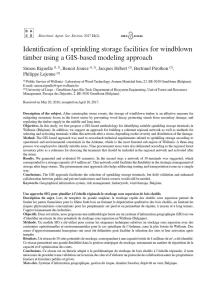Riguelle S., Jourez B., Hébert J., Pirothon B., Lejeune P.
After catastrophic storm events, the storage of windblown timber is an effective measure for mitigating economic losses in the forest sector by preventing wood decay, protecting stands from secondary damage, and regulating the timber supply in the middle and long term.
Objectives. In this study, we first propose a GIS-based methodology for identifying suitable sprinkling storage terminals in Wallonia (Belgium). In addition, we suggest an approach for building a coherent regional network as well as methods for selecting and activating terminals within this network after a storm, depending on the severity and distribution of the damage.
Method. The GIS-based approach was used to crosscheck technical requirements related to sprinkling storage according to operational and environmental constraints in the Ardenne, which is the most forested sub-region of Wallonia. A three-step process was employed to identify suitable areas. Nine procurement areas were also delineated according to the regional forest inventory plots as a reference for choosing the terminals that should be included in the regional network and activated after the storm.
Results. We generated and evaluated 96 scenarios. In the second step, a network of 30 terminals was suggested, which corresponded to a storage capacity of 4 million m³. This network could facilitate the flexibility in the strategic management of storage after huge storms. The procurement area approach also helps addressing routing and transportation issues in a simple way.
Conclusions. The GIS approach facilitates the selection of sprinkling storage terminals, but field validation and enhanced collaboration between public and private landowners and forest owners would still be needed.
Consultez la notice complète de l’article sur ORBi

